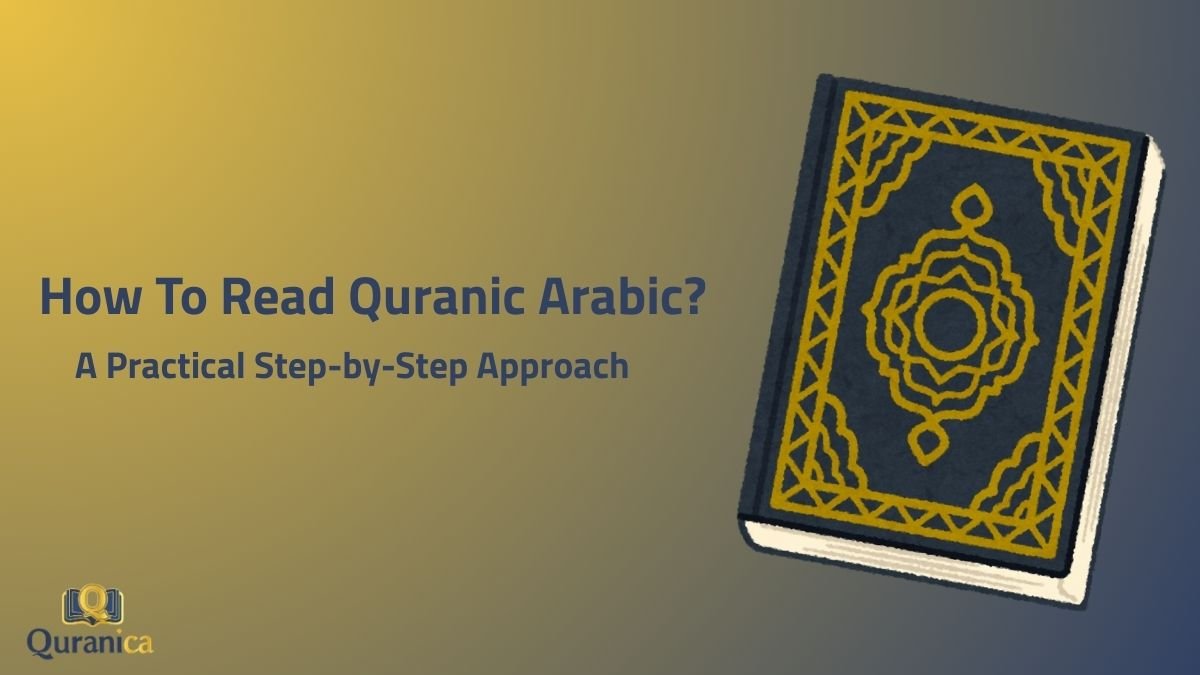I want to make this article very practical for you. So, we will go step by step, just like if we are in the classroom together.
I want to take your hand, step by step, and show you how you can begin to read the verses of the Quran in Arabic. We will take it effectively, insha’Allah, and the most important thing is that you can start to read Quranic Arabic by the end of this.
First, let’s understand what it means to read Quranic Arabic.
Reading Quranic Arabic is about knowing how to pronounce the Arabic letters, how these letters connect, how the small signs above and below them change the sounds, and how to pronounce the words correctly as they were revealed to our Prophet Muhammad (peace be upon him).
So, ready to start? Let’s begin with the first step
Step 1: Learn the Shapes and Sounds of the Arabic Alphabet
The first step, naturally, is to learn the Arabic alphabet. Arabic letters might look different from the alphabet you are used to, but it’s a logical system with consistent sounds.
Each Arabic letter has a unique shape, and most letters will change their form depending on their position in a word (beginning, middle, or end).
Let’s take a look at the first few letters and their basic sounds. Remember that Arabic is written from right to left.
| Letter | Name | Isolated Form | Initial Form | Medial Form | Final Form | Closest English Sound/Transliteration |
| ا | Alif | ا | ا | ـا | ـا | a as in Dad / ā |
| ب | Baa’ | ب | بـ | ـبـ | ـب | b as in bake / b |
| ت | Taa’ | ت | تـ | ـتـ | ـت | t as in take / t |
| ث | Thaa’ | ث | ثـ | ـثـ | ـث | th as in thin / th |
| ج | Jiim | ج | جـ | ـجـ | ـج | j as in joke / j |
This is just a glimpse because we have a detailed article on Quranic Arabic Alphabet.
You will need to learn all 28 letters and practice recognizing them in their different forms.
And of course, Quranica offers excellent introductory course that will guide you through the alphabet with expert teachers.
Step 2: Recognize the Short Vowels in Quranic Arabic
In Quranic Arabic, we have short vowel sounds that are shown by small signs above or below the letters. These are called “Harakat”. There are three main short vowels:
- َ (Fat-ha) – A small line above the letter. نَ (na) – This makes an “a” sound, like the “a” in “apple”..
- ِ (Kasra) – A small line below the letter. نِ (ni) – This makes an “i” sound, like the “i” in “ink”.
- ُ (Damma) – A small sign that looks like a small “و” above the letter. نُ (nu) – This makes a “u” sound, like the “u” in “put”.
Now, let’s try to read Quranic Arabic with these short vowels. Take the first verse of Surah Al-Asr (103:1):
“وَٱلْعَصْرِ”
Let’s break down the first word:
- وَ (Wa) – The letter و (Waaw) with a َ (Fat-ha) makes the sound “wa”.
- لْ (Al) – The letter ل (Laam) with a ْ (Sukoon, which we will learn later) after the ا (Alif). We don’t pronounce the Alif here.
- عَ (‘A) – The letter ع (‘Ayn) with a َ (Fat-ha) makes the sound “‘a”.
- صْ (S) – The letter ص (Saad) with a ْ (Sukoon). We stop at this letter, making an “s” sound.
- رِ (Ri) – The letter ر (Raa) with a ِ (Kasra) makes the sound “ri”.
Putting it together, with practice, you will read this in Quranic Arabic as: “Wal-‘Asr”. The translation is: “By time,”.
See how the short vowels help us to pronounce the word?
Step 3: Recognize the Long Vowels in Quranic Arabic
Sometimes, the vowel sound is longer. In Arabic, we show this with special letters that follow the short vowel. These are called “Huruf Madd” (letters of prolongation):
- ا (Alif Madd) – When an ا (Alif) comes after a letter with a َ (Fat-ha), it makes the “a” sound longer, like the “a” in “father”. For example, بَا (baa).
- ي (Yaa Madd) – When a ي (Yaa) comes after a letter with a ِ (Kasra), it makes the “i” sound longer, like the “ee” in “see”. For example, بِي (bee).
- و (Waaw Madd) – When a و (Waaw) comes after a letter with a ُ (Damma), it makes the “u” sound longer, like the “oo” in “food”. For example, بُو (boo).
Let’s look at the second verse of Surah Al-Asr:
“إِنَّ ٱلْإِنسَانَ لَفِى خُسْرٍ”
Consider the word ٱلْإِنسَانَ:
- ـَا (aa) – The letter ا (Alif Madd) comes after سَ (Sa with Fat-ha), making the “a” sound long. So, it is “saa”.
So, you would read this part in Quranic Arabic as “…Al-Insaana…”. The translation of the whole verse is: “Indeed, mankind is in loss,”.
Can you hear the difference between the short “a” in عَ (‘a) and the long “aa” in ـَا (aa)? This is important for reading Quranic Arabic correctly.
Step 4: Understand Tanween Role in Quranic Arabic
Tanween is when we have a double short vowel at the end of a word. Tanween gives a sound like adding an “n” at the end.
- ـً (Tanween Fat-h) – Two Fat-has at the end make an “an” sound. For example, بَـً (ban).
- ـٍ (Tanween Kasr) – Two Kasras at the end make an “in” sound. For example, بِـٍ (bin).
- ـٌ (Tanween Damm) – Two Dammas at the end make an “un” sound. For example, بُـٌ (bun).
Look again at the second verse of Surah Al-Asr:
“إِنَّ ٱلْإِنسَـٰنَ لَفِى خُسْرٍ”
Notice the last word: خُسْرٍ
- خُسْ (Khus) – The letters خ (Khaa) with ُ (Damma) followed by سْ (Seen with Sukoon) make the sound “khus”.
- رٍ (rin) – The letter ر (Raa) with ـٍ (Tanween Kasr) makes the sound “rin”.
So, you would read this word in Quranic Arabic as “khusrin” when you connect it with the following word without stopping.
Read more about: Quranic Arabic Alphabet – Full Guide
Step 5: Learn Sukun Role in Quranic Arabic
Sukun is a small circle ْ above a letter. It means that this letter has no vowel sound. It is just the pure sound of the letter, and it connects to the letter before it.
We saw an example of Sukun in the first verse: وَٱلْعَصْرِ in the لْ (al) and صْ (s) parts.
Step 6: Understand Shadda role in Quranic Arabic
Shadda looks like a small small “س” ّ above a letter. Shadda means that this letter is pronounced twice.
Let’s take the third verse of Surah Al-Asr:
“إِلَّا ٱلَّذِينَ ءَامَنُوا۟ وَعَمِلُوا۟ ٱلصَّـٰلِحَاتِ وَتَوَاصَوْا۟ بِٱلْحَقِّ وَتَوَاصَوْا۟ بِٱلصَّبْرِ”
Look at the word ٱلَّذِينَ:
We saw Shadda in the word ٱلَّذِينَ (alladheena). The لَّ has a Shadda and a Fat-ha. It is like saying “lal”. So, in ٱلَّذِينَ, it’s like saying “al-ladh…” with a strong emphasis on the “l”.
Let’s take another word from the third verse: ٱلصَّـٰلِحَـٰتِ
- ٱلْ (al) – Alif + Laam with Sukoon.
- صَّـٰ (saa) – Saad with Shadda and Fat-ha followed by Alif Madd. It’s like saying “ssaa”.
- لِ (li) – Laam with Kasra.
- حَا (haa) – Haa with Fat-ha followed by Alif Madd.
- تِ (ti) – Taa with Kasra.
So, you read this word in Quranic Arabic as “as-saalihaati”. The Shadda makes the “s” sound very strong and doubled.
Read more about: How to Learn Quranic Arabic? A 7-Step Guide
Step 7: Recognize the Definite Article “Al-” & Sun and Moon Letters
The word “ٱلْ” (Al-) is the definite article “the” in Arabic.
Sometimes, when it comes before certain letters, the ل (Laam) in “Al-” is not pronounced.
These letters are called “Sun Letters” (الحروف الشمسية).
The Sun Letters are: ت ث د ذ ر ز س ش ص ض ط ظ ل ن
The letters before which the Laam is pronounced are called “Moon Letters” (الحروف القمرية).
The Moon Letters are: ا ب ج ح خ ع غ ف ق ك م هـ و ي
If a word starts with a Sun Letter after “Al-“, the Laam in “Al-” merges with that letter, and that letter gets a Shadda.
You see this in Surah Al-Asr in the word وَٱلْعَصْرِ. ع (‘Ayn) is a Moon Letter, so we pronounce the Laam: “Wal-‘Asr”.
And in ٱلصَّـٰلِحَـٰتِ (Saad) is a Sun Letter, so we read it in Quranic Arabic as “as-saalihaati” (where the Laam merges with the Saad).
Step 8: Putting It All Together – Let’s Read Surah Al-Asr
Now that we have learned the basics let’s try to read the entire Surah Al-Asr, applying all the rules we have learned:
بِسْمِ ٱللَّـهِ ٱلرَّحْمَـٰنِ ٱلرَّحِيمِ
وَٱلْعَصْرِ ﴿١﴾ إِنَّ ٱلْإِنسَـٰنَ لَفِى خُسْرٍ ﴿٢﴾ إِلَّا ٱلَّذِينَ ءَامَنُوا۟ وَعَمِلُوا۟ ٱلصَّـٰلِحَـٰتِ وَتَوَاصَوْا۟ بِٱلْحَقِّ وَتَوَاصَوْا۟ بِٱلصَّبْرِ ﴿٣﴾
“By time, (1) Indeed, mankind is in loss, (2) Except for those who have believed and done righteous deeds and advised each other to truth and advised each other to patience. (3)”
- وَٱلْعَصْرِ (WaalAAasri):
Wa (و – Waw with Fatha) – Al (‘الـ’ – Alif with Fatha, followed by Laam with Sukun, then Ayn with Fatha) – ‘As (عَصْ – Sad with Sukun) – ri (رِ – Raa with Kasra).
- إِنَّ ٱلْإِنسَـٰنَ لَفِى خُسْرٍ (Inna alinsana lafee khusrin)
- إِنَّ (Inna): Alif with Kasra + Noon with Shadda and Fat-ha
- ٱلْإِنسَـٰنَ (alinsana): Al (‘الـ’ – Alif with Fatha, followed by Laam with Sukun) – In (إِ – Alif with Kasra followed by Noon with Sukun – نْ) – saa (سَـٰ – Seen with Fatha followed by Alif for long ‘aa’ sound) – na (نَ – Noon with Fatha).
- لَفِي (Lafee): Laam with Fat-ha + Faa with Kasra + Yaa Madd
- خُسْرٍ (khusrin): Khaa with Damma + Seen with Sukoon + Raa with Tanween Kasr
- إِلَّا ٱلَّذِينَ ءَامَنُوا۟ وَعَمِلُوا۟ ٱلصَّـٰلِحَـٰتِ وَتَوَاصَوْا۟ بِٱلْحَقِّ وَتَوَاصَوْا۟ بِٱلصَّبْرِ
(Illa alladheena amanoo waAAamiloo alssalihati watawasaw bialhaqqi watawasaw bialssabri)- إِلَّا (Illaa): Alif with Kasra + Laam with Shadda and Fat-ha + Alif Madd
- ٱلَّذِينَ (alladheena): Alif (silent) + Laam with Shadda and Fat-ha + Dhaal with Kasra + Yaa Madd + Noon with Fat-ha
- ءَامَنُوا۟ (aamanoo): Hamza with Fat-ha + Alif Madd + Meem with Fat-ha + Noon with Damma + Waaw Madd + Silent Alif
- وَعَمِلُوا۟ (wa’amiloo): Waaw with Fat-ha + ‘Ayn with Fat-ha + Meem with Kasra + Laam with Damma + Waaw Madd + Silent Alif
- ٱلصَّـٰلِحَـٰتِ (as-saalihaati): Alif (silent) + Saad with Shadda and Fat-ha + Alif Madd + Laam with Kasra + Haa with Fat-ha + Alif Madd + Taa with Kasra
- وَتَوَاصَوْا۟ (watawaasaw): Waaw with Fat-ha + Taa with Fat-ha + Waaw with Alif Madd + Saad with Fat-ha + Waaw Madd + Silent Alif
- بِٱلْحَقِّ (bil-haqq): Baa with Kasra + Alif (silent) + Laam with Sukoon + Haa with Shadda and Kasra
- وَتَوَاصَوْا۟ (watawaasaw): Waaw with Fat-ha + Taa with Fat-ha + Waaw with Alif Madd + Saad with Fat-ha + Waaw Madd + Silent Alif
- بِٱلصَّبْرِ (bis-sabr): Baa with Kasra + Alif (silent) + Saad with Shadda and Fat-ha + Baa with Sukoon + Raa with Kasra
Alhamdulillah! You have now broken down and (hopefully) read a short Surah in Quranic Arabic.
Of course, this is just the beginning. To become fluent in reading the Quran in Arabic, you need more practice and guidance and more rules of Tajweed.
That is where Quranica can help you immensely. Our courses are designed by experienced Quran teachers who understand the difficulties faced by non-Arabs in learning to read the Quran.
We offer step-by-step lessons that will take you from recognizing the alphabet to reading complete Surahs with Tajweed.
Your Journey Begins Now with Quranica:
In our Reading Quran course, you will:
- Learn the Arabic alphabet with correct pronunciation from native Arab teachers.
- Master the short and long vowels, Tanween, Sukun, and Shadda through clear explanations and practical exercises.
- Practice the rules of “Al-” and Sun and Moon letters.
- Practice reading verses and Surahs from the Quran with guidance and feedback.
- Learn about Tajweed rules to beautify your recitation.
Join Us NOW!
Conclusion:
Mastering Quranic Arabic requires an understanding of the alphabet, pronunciation rules, and phonetic markers. It begins with learning the Arabic letters, which change shape depending on their position in a word. Vowel markings, known as Harakat, play a crucial role in pronunciation—short vowels (Fat-ha, Kasra, and Damma) indicate brief sounds, while long vowels (Huruf Madd) extend pronunciation.
Beyond vowels, additional linguistic features refine pronunciation. The Sukun symbol marks consonants without vowels, while Shadda indicates double consonants. Tanween introduces a nasalized sound at word endings, and the definite article “Al-” interacts with Sun and Moon letters, influencing pronunciation.








0 Comments